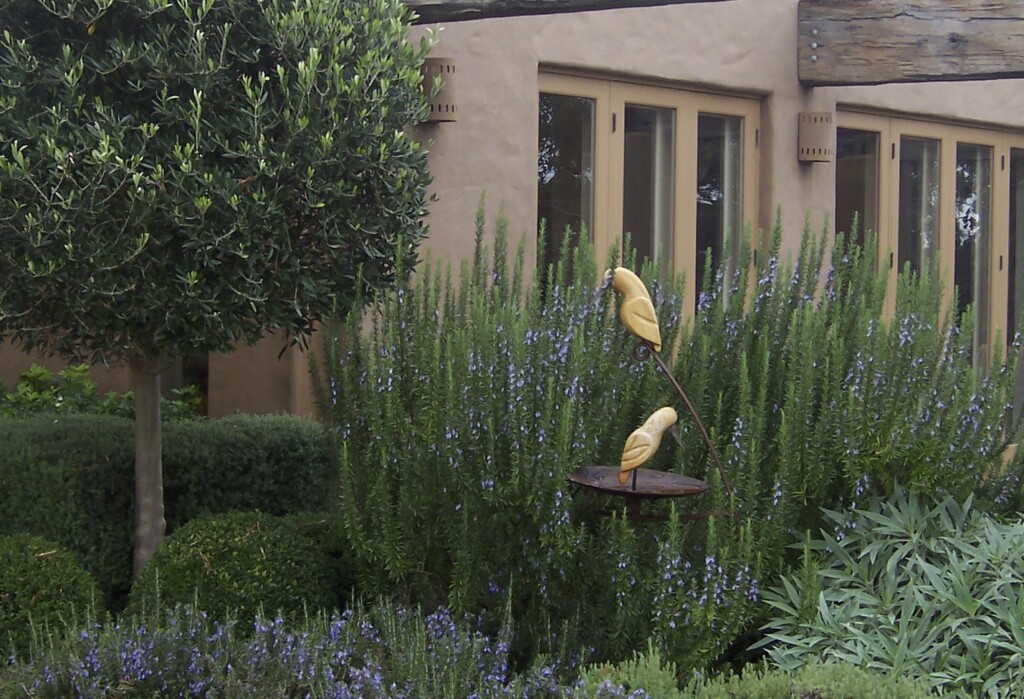Have you ever thought about how few shrubs there are that carry within their structure any strength of form? A number have a predictable shape, but form – which says more about the visible ‘forces’ within the plant – is rare indeed.
That’s why I can’t stop using Rosemary ‘Tuscan Blue’. When young, and then when kept young by hard pruning, it’s about as rigidly vertical as a shrub can get. Its bolt upright stems stand out like reassuring compass points amongst the floral froth of low to medium perennials, or the amorphous fuzz of many shrub plantings. A not dissimilar verticality was provided by an much older form of rosemary, but its flowers were such a murky grey-blue that I was hardly tempted to use it. ‘Tuscan Blue’ is a really strong purple-blue against vibrantly green foliage. Best of all, it flowers now.

Last winter, one of my plants outside the dining room window was in particularly heavy bloom and was visited every morning by a local Eastern Spinebill. As long as I could consume my fruit and yoghurt with super-smooth movements, we could dine together at length.
Like all rosemaries, Rosemary ‘Tuscan Blue’ needs no supplementary watering in my climate, and is happiest, and longest-lived, in really poor, well-drained, skeletal soil. The happiest of my plants is never watered, and is planted in very sandy soil atop a retaining wall, in full sun, facing north.
All it requires is to be cut back hard every year. I say ‘all it requires’ in order to convey its minimal demands, but I’ve got to confess, this isn’t as easy to force oneself to do as I’d like to make out. The trouble is (and this goes for all rosemaries I’ve grown) they start to put on spring growth while still fully in bloom, and by the time their long flowering season is over, you feel like you’re cutting off all of this year’s new growth. Better to really hack into it in late winter, when it’s still in flower, and get all the benefit of that spring re-growth, particularly if you’re growing it dry, as that spring burst may account for a large proportion of its annual growth potential.

Having said that, Rosemary ‘Tuscan Blue’ must be one of the very best for making barbecue skewers, so your pruning efforts aren’t without immediate benefits. Just thread on some chunks of lamb or pork and away you go. By sheer chance, there’s several plants near our barbecue, so even when I’m not using the stems as skewers, I can’t help throwing a few branches on top of or amongst whatever it is I’m cooking, for that extra aroma and flavour.
Finally, it may have escaped your notice that rosemary is now officially known as Salvia rosmarinus. So I should really be writing Salvia rosmarinus ‘Tuscan Blue’. But I’m not ready for that yet. I just need some time.
MIHAEL CAN YOU POSSIBLY POST A PIC OF ROSEMARY AFTER PRUNING? I FIND IT SO HARD TO DESTROY THE LOVELY VERTICALITY OF MINE, AND THEN JUST AS THE GARDEN IS GETTING READY TO OPEN!
That’s a great idea Jill. It’ll be a little while until I prune mine, but when I do, I’ll post a pic. I think I took a pic after pruning the one photographed for the title pic above – I know I was in such a panic about brutalising it to that extent that I may have taken it so I could record the regrowth. I’ll take a look
Nup. Just checked. I didn’t take one. I’ll do it this year
The issue I have with winter pruning is that bees spend their winter feeding on my rosemary, I’d feel too guilty depriving them of their food source. Though I have started pruning every second plant as an option.
That’s such a great solution. And while I don’t like pruning them after flowering (due to the inevitable removal of a heap of new growth), they’re mostly OK with it, just taking a little longer to recover.
Oh no, not another plant name change. I don’t think I’ll ever be ready to call Rosemary, Salvia!
Same!
Hey Michael, just read your great article on the Tuscan blue and I think I need your help. I have a hedge of the Tuscan blue and whole stems of the bushes turn yellow then brown when they reach 2-3 ft in height. Looks pretty ugly. Can you help?